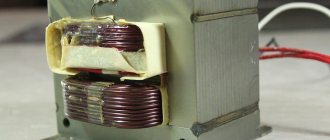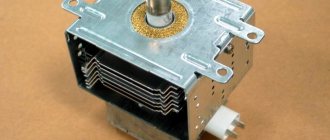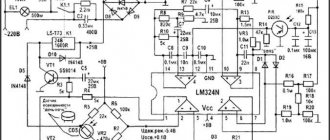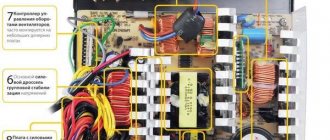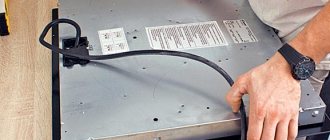We are 100% sure: it’s enough to understand what’s inside to repair the microwave. Let's start with the simplest model, inside of which there is a grill and a turntable, then it is not difficult to generalize the case to inverter models. We speak in simple language, because we discovered: when discussing a topic on the Internet, they either speak useless nonsense, or speak in too highly specialized language, difficult to understand.
The device of a simple microwave oven
In a microwave oven, electrical components are connected in series. Let's start with the magnetron power circuit. Open the lid and you will see a huge transformer, next to it is a large (really large) capacitor, next to which there is a diode and a fuse in a ceramic case (insulator). These things are the first thing that attracts the attention of a beginner. This is a circuit for generating high voltage (3-5 kV) power supply to the magnetron. Don't put your hands or a screwdriver in there. We believe that the capacitor will gradually discharge, and if the plug is pulled out of the socket, an electric shock is unlikely. The operating principle is as follows:
- A voltage of 230 V is supplied to the primary winding of the transformer. The coil is located at the bottom, wound with a copper core, which at times appears to be bare. The metal is coated with transparent lacquer insulation. The coil is located under the secondary windings.
- There are two secondary windings. One is literally several turns of copper wire wound carelessly next to the primary: cathode heating. Provides 6.3V AC voltage to help electrons escape the surface. Above, in good, high-quality insulation, the high-voltage winding is located. Gives 2 kV going to the output, powering the magnetron.
- At the output there is a capacitor shunted by a diode. It turns out that the negative half-wave passes to the cathode, the positive half-wave charges the capacitance. At the next half-cycle, the electrode will already be under double the voltage: that taken from the transformer and the discharge of the capacitor. The result is about 4 kV. Enough to start generation.
Please note: the output windings are paralleled on the magnetron, the cathode has two inputs. The anode is grounded separately.
This results in an electrical layout:
- A current with a voltage of 6.3 V flows through the heating coil.
- A potential of 4 kV is applied to the cathode, which is balanced by ground at the anode.
The heating coil and cathode are electrically connected. The power of the magnetron is controlled by a timer, and to prevent sparks from occurring, a starting relay is added to the circuit. Let's move on to the front panel!
As easy as pie
If you are not going to tinker with spare parts, wires, or make at least some kind of device, it is quite possible to create a storage facility for bread. To do this, you need to remove all the insides and cut off the cord. The box will become much lighter.
To give it a presentable look, the top can be decorated to your taste. Some people use the decoupage technique, others solve the problem even simpler - they cover it with self-adhesive wallpaper.
What is important is that here any bakery products can be perfectly stored in paper bags without drying out. What else can you make from a microwave with your own hands?
Front Panel
On the front panel of the microwave oven there is a mechanical programmer that sets the modes. Under the round handle lies a shaft equipped (in our case) with two cam disks. The first is responsible for powering the transformer that forms the power supply for the magnetron, the second is responsible for the quartz grill lamps. The buttons of two relays are controlled by cam mechanisms:
- a key transistor that blocks power supply to the magnetron;
- quartz grill lamps.
If the cam is low, the button is released, the relay is in normal position. When the protrusion height is high, the relay button is pressed. It is easy to see that this way we will ensure a constant supply of voltage, but we need to regulate the power. We'll talk more below, but first let's get back to the start relay. The contraption, which initially removes the current load, is connected in parallel to the input winding of the transformer. Power contacts are connected in series. There is a capacitor and a zener diode in parallel with the relay.
When the front forms a spark, the capacitance presents zero resistance to the differential, the inductance of the transformer is separated by open contacts. Large current does not flow! The capacitance begins to charge to a voltage limited by the zener diode. A diode turned in the right direction prevents the discharge. When the threshold value is exceeded, the relay is activated and a large current flows to the transformer and power supply to the magnetron. Due to a well-thought-out design, microwave oven timers with a protective relay almost never burn out. Now the programmer!
Equipped with a gear, toothed transmission that regulates the clock. Depending on this, the periods of operation and downtime of the magnetron change. The longer the rest, the less power is released. About the magnetron, let us add: the introduction of inverter control shifts the control of cycles from the timer to the sensor circuit for measuring temperature. The sensor evaluates the emission spectrum of the food and decides how to operate the microwave oven. It is not the downtime (operation) of the cycle that changes, but the duty cycle of the pulses. More frequent packets, more power. As a result, it becomes possible to flexibly adapt to the current situation.
All the details come into play!
The most interesting thing is that you can use not only the body of a broken microwave oven, but also its entire “internals”.
When you make a bread box, even an “oven,” you don’t use the parts inside.
We didn’t just warn you that you shouldn’t throw anything away! The easiest option is to sell whole elements. Even if it’s small, it’s money.
But for DIYers, this is a great reason to create something unique and unusual.
Safety relays
Before talking about the grill, the magnetron cooling fan, the work compartment light bulb and the table motor, I would like to mention the protective relays. Contactors ensure complete shutdown of mechanisms when the door is opened. Two break the power circuit (ground and phase), one necessarily controls the performance of the other:
- The door is open, the relay buttons are released, the contacts that were initially normally closed are connected.
- In this case, the power supply circuit must be broken twice.
- But in the second relay the ground is shorted to phase.
- The first relay worked - nothing bad happens, the circuit is already broken.
- The first relay is stuck and the fuse will blow because the ground is shorted to phase.
Interrupt the program by opening the doors. Perform the necessary operations. Close the compartment. The program will continue executing. Electromagnetic radiation instantly disappears as soon as the protection relay breaks its contacts.
Not a power fuse placed in the housing and hanging under the magnetron, but located on the electronic board. Consider the curious features of protective relays. One (third) supplies a phase to the starting relay. Without this, supplying voltage to the magnetron is in principle impossible. The power fuse estimates the energy consumption of the magnetron. If an emergency situation occurs, the protective element burns out, protecting the generator from damage. The described thing will happen if you turn on an empty microwave oven, or put a fork, spoon, or metal object inside. The only bordering golden ring of the plate can provoke an emergency situation.
Safety
To operate your microwave oven safely, you must follow all applicable installation and care instructions.
The metal case and special catchers around the perimeter of the door will protect you from exposure to microwave radiation. The energy converter and transformer are protected from overheating by cooling with a specially built-in fan. When you turn on the microwave, the door is immediately locked to prevent accidental opening. But after opening, the electrical circuit opens and the sensors turn off the magnetron.
Location of the main components of the microwave
High power consumption in the oven is an increased hazard. An electrical network with a grounding wire will significantly protect you from electric shock. It is prohibited to use grounding through water or gas pipes. This can lead to irreparable consequences.
If there is no grounding, do not touch the microwave body and pipes at the same time. This can lead to a short circuit and it is not a fact that in this situation the machine will work. In order to protect children, the microwave is equipped with a lock to turn on the microwave.
Service Mechanisms
Typically, a swarm of units is connected in series in a microwave oven. Now we are discussing secondary mechanisms: fan motors, table motors, quartz grill lamps, backlight bulb. This is done to reduce the number of wires. Design changes simplify microwave repair to the maximum. Result: burnout of one element blocks the operation of the furnace. The magnetron threshes, as does the start relay. The noted effect is a characteristic sign of the cause hidden in the auxiliary mechanism. An equivalent result if the third relay breaks, breaking the power circuit in the normal state (the door is open and the button is released). but if a relay is powered from it (as stated above), microwave oscillations will not be generated.
The above diagram is typical for microwave ovens; we believe there are other designs. Just take note of the designers' imaginations. The elements inside the microwave oven are powered by 220 volts. There are no other special sources inside. Models stuffed with electronics stand out sharply. An inverter requires a number of voltages to operate.
I would like to note that in microwave ovens with hybrid modes you can test almost 100% of the component parts of the product separately. Study the design of the programmer. It is convenient to shine the light on the grill while the magnetron is turned off. Beginners are perplexed: how to regulate the power of the grill. We believe that the share of this component of the microwave oven is made up of energy not consumed by the magnetron. The microwave operates longer, leaving less time for other components of the electrical circuit.
Now let’s say a few words regarding the occurrence of a fire inside a microwave oven: thunder and lightning strike. At the output of the waveguide that transmits microwave energy to the compartment, there is a mica filter. Visually dense fabric, reminiscent of building insulation. The surface must be clean and dry. Otherwise, thunder and lightning will arise without difficulty. Fat contributes to the breakdown of the insulation, resulting in a discharge inside. Be foolish enough to put a plug in the compartment - lightning will easily pierce the enamel coating. A black spot will remain; in the worst case, the wall will burn through.
The main types of malfunctions are listed, the design is described - we hope that readers will play the presentation.
Please note that microwave radiation is harmful to health. Therefore, repairing microwave ovens on a regular basis cannot be called the best job.
What to do if the microwave does not turn on
When the microwave does not turn on, a beginner will be able to repair a few parts on his own. The fuses are replaced with new ones of similar current strength. In most microwave models, this is 12 A. Buy the necessary protective element and install it in place of the burnt one. Similarly, you can replace the temperature sensor or damaged limit switches.
If you know how to use a soldering iron, you can remove a faulty capacitor or its diode. It is easy to replace the inductor or diodes on the control board.
When the microwave does not turn on due to a burnt-out transformer, it is better to contact a service center. The technician will replace the element with a similar one in terms of power and voltage increase. If such a model is not available, no problem - the craftsmen know how to rewind the windings and re-varnish them, restoring the coil capacity and insulation.
You will have to contact the service if the zener diode or its starting capacitor breaks down. The block is quite difficult to disassemble - the metal cover needs to be flared. Only a master will do this carefully.
Typical breakdowns
In microwave ovens, the weak point is the inability of the owners to properly operate the product. Buyers are sure: plates with a gold rim cannot be placed inside, the dishes will break (the metal rim will peel off), not the microwave. Conventional thinking is wrong. If you place a steel spoon inside, there is a high probability of an electric arc; if the stream of ionized air does not burn the magnetron (high-voltage fuse), it will leave indelible marks on the walls of the working compartment.
Mica gasket
Let's start with a typical breakdown: a breakdown of the housing at the mica gasket. The magnetron, through a pin, supplies energy to the waveguide, which is sensitive to the presence of contaminants inside. Grease stains burn, spark, and interfere with the normal operation of the device. Therefore, the output of the waveguide is covered with mica cloth. The soft, flexible material, which is relatively inexpensive, is sold in large pieces; use scissors to form a piece into a suitable shape. The operating principle is based on the ability of mica to pass the 2.45 GHz frequency of microwave oven heating. Otherwise, the fabric will get very hot and burn out after a short period of use. Mica prevents the conductive walls from getting wet - this is important if soup is heated inside: flying splashes cause irreparable damage to the cleanliness of the compartment. It has long been noticed: water absorbs radiation at 2.45 GHz, which promises trouble. If liquid gets inside the waveguide, an emergency situation will immediately arise: evaporation of molecules, changing the dielectric properties of the air medium, instantaneous breakdown, burnout of the high-voltage fuse, in the worst case, the magnetron and other electronic components.
Why does the protective mica gasket become unusable? The housewife prepares food, often including fat, oil, and other substances among the ingredients in the recipe. The substances do not boil, they shoot out dirty drops. The fat gets onto the mica tissue and a conductivity bridge is formed. Separately, the natural mineral is a dielectric; it reliably isolates the waveguide from the housing; a single drop of oil that soaks the gasket can blow up this wall. An arc is instantly formed:
- between the walls of the waveguide and the mica fabric;
- between the mica fabric and the body.
Thunder and lightning are the first sign of impending microwave failure.
Proper grounding
If the device is not grounded, the situation is extremely dangerous. Enough to grab the kitchen faucet with your right hand (expose your palm to the stream of water), or accidentally touch the microwave oven with your left hand and you will die. It is appropriate to recall: devices connected near water sources operate in tandem with a differential circuit breaker. Grounding must be done correctly. Often it is not enough to neutralize the corresponding terminal. We look at two pitfalls:
Microwave
- Grounding resistance is negligible. Units, fractions of an ohm. 10 is already considered an unacceptable value. Therefore, the circuit often uses not wires, but tires (strips) of steel or other metal (alloy) of large cross-section. It is clear that such conditions cannot be provided for a home network.
- The differential circuit breaker works by detecting the leakage current. The output and input quantities are measured and the difference is found. If the leakage current goes to ground by zeroing, the magnitude of the difference is zero, even when the fuses are burned by overload, and the magnetron in addition.
Differential protective devices often have fuse slots, but should not be confused with safety functions. The dark humor of TV repairmen says:
- The fuse burns out last, when everything that could break has already broken.
This means that the differential protection device cannot save human lives. The microwave oven must be properly grounded. The devices belong to electrical safety class I. The terminal is located on the plug. Install European sockets that are connected correctly. And this is primarily grounding; why has already been explained. Let us add that a regular outlet or fuses may not protect you from an accident. In the case of a microwave oven, the chance of a favorable outcome of the accident is high.
High voltage fuse
Regarding what has been said, many have a question mark in their heads the size of a mountain, what is a high-voltage fuse. Let's explain! The microwave oven device includes two fuses (minimum):
- An ordinary small transparent (glass), white (porcelain) cylinder on an electronic board. Ensures the safety of hinged, integrated elements. The fuse is low voltage and belongs to the power supply circuit of the electronic board. It will burn out if the capacitor breaks, shorting the resistor located on the printed circuit board.
- The magnetron has its own power generation circuit, formed by a step-up transformer, diode, and capacitor. The source applies a potential of several kilovolts to the cathode. Items are easy to find. The capacitor looks monstrous: a hundred gram steel can, to which a diode is attached at the end, the second leg is soldered (screwed) to the body. Nearby you will notice a ceramic or other dielectric chest (often brown). Inside the Egyptian sarcophagus there is a high-voltage fuse. Protects the magnetron against overheating. If the cathode current becomes too high (the mica gasket breaks through, or someone puts a spoon into the working compartment), the high-voltage fuse will burn out first. By the way, microwave oven repair technicians rarely complain about the power element. Therefore, it performs its duties properly (or, conversely, causes the magnetron to fail).
You cannot remove the high-voltage fuse from the electrical circuit and try to make an accessory with your own hands. It is simply dangerous for the device and people around it. There will be a fire and someone will be electrocuted.
Magnetron voltage generation circuit
Of course, you’ve heard about inverter microwave ovens. Firstly, the design is not very different from standard microwaves, and secondly, not everyone likes the flexible heating control mode; it is imperfect. The designers provide the ability to disable the option, and the cooks use it. To understand how a scientific-sounding inverter microwave oven works, consider the magnetron voltage generation circuit:
- The microwave oven starts with a power transformer. The input winding is below the secondary, assembled with copper wire with varnished transparent insulation (heat transfer to the outside by infrared radiation) for better cooling. Above there are a couple of sloppy turns that form the 6.3 volt voltage of the cathode filament. Finally, the step-up winding is located on top, from where a potential of 2 kV (amplitude) is supplied to the rectifier.
- The anode of the magnetron is placed on the neutral wire (not the housing). The cathode is additionally heated to make it easier for electrons to leave the emitter surface. Negative voltage is used for power supply. The capacitor is positively charged. The next half of the period the cathode is under double voltage. The potential difference is formed by the difference between the secondary winding of the transformer and the capacitor. A forced measure to reduce the requirements for the power part of the electrical circuit.
- A mains voltage of 230 V is supplied to the primary winding of the transformer. In the case of inverter control, the duty cycle of the pulse sequence is modulated. As a result, the result is determined by the effective value. The farther apart the pulses are, the lower the level, and the less power the magnetron gives to the food.
Please note: the magnetron has two terminals and three wires. The single one powers the filament, while the double one supplies energy to the cathode and closes the 6.3 V circuit. The anode is connected separately, at the back of the ingenious design. To supply voltage to the transformer, the electronic circuit contains a relay. The measure protects the programmer (timer-controlled contacts) from sparking. A zener diode and a capacitor are connected in parallel to the relay, taking the shock of the front of the connected voltage. The armature is then released and power is supplied to the transformer. When the microwave oven is operating, clicks are periodically heard - the relay in question. The use of a structural part significantly increases the service life of the timer.
Timer (programmer)
The programmer is often formed by mechanical relays. The rod shaft contains a ring of different heights. By rotating the knob, we select a combination of states of the relay group. Depending on this, the microwave oven switches to the desired mode. It is clear that there is nothing to break here (and if it breaks, it is difficult to restore). We will check each relay if necessary; such steps are not required more often. The grill contact has failed and the lamps will go out. Let's say the same about the magnetron circuit.
The timer is more complicated. The shaft is lined with gears, each making (opening) a contact. In a microwave oven without inverter control, the timer sets the frequency of turning on (off) the magnetron. The relay mentioned above blocks the sparking of the timer contacts. With inverter control, there is an infrared radiation sensor in the compartment; according to the sensor readings, the duty cycle of the pulses (frequency) is controlled.
What can break. Imitating a clock mechanism, there is a spring inside the timer. If you notice a breakdown, you should replace the steel with a new one. The mechanism is durable, contacts rarely break. We described the main types of faults, of course, you need to start with the cord. A trivial breakdown, to blame in 20% of cases. Now readers understand a fair amount of how to fix a microwave oven.
Magnetron internal short circuit
In inverter microwave ovens, designers introduced a negative magnetron electrode. To verify that the magnetron is not actually functioning:
- Put water in the oven.
- Turn it on for a minute and a half and listen carefully.
- If a sound is heard that is interrupted, then this indicates that the magnetron has run out of cathode emission and electrons have flown out.
- It itself practically does not heat up and, accordingly, the water will also be cool.
- If this component of the system is broken, it should be replaced:
- Unscrew the magnetron - discharge the heat exchanger, remove the power, unscrew the air vent from it so that it does not interfere, and unscrew the bolts.
- Install another one, securing it with bolts. The waveguide system is organized in such a way that it is possible to catch on the edges with both washers and hooks. When changing certain types of magnetrons, it is possible to drill holes for screws directly in the waveguide if the holes do not match. The main thing here is that ventilation is observed and oriented correctly
- Replace the air duct.
- Check its operation - install the water, turn it on and listen. At the beginning of work, it may crackle a little. The water should be warm and the magnetron too.
Be especially careful not to leave debris in the waveguide when changing. The litter will lead to disorder of microwave waves in the waveguide, as a result of which the stove will emit radioactive waves.
Microwave oven breakdowns
Many people are interested in how to check whether the oven produces the required characteristics. In literary sources it is written: the measurement method is in NVN 100 GOST 19308 - 80; Provides a graphic and useful information to guide the assessment process. The beginning of the paragraph is taken from a book on repairing microwave ovens, published in 2003. It is alarming that GOST is difficult to find in practice. The authors googled and found GOST R IEC 60705-2011. And the document is called “Household microwave ovens. Methods for measuring functional characteristics." It is from him that he is invited to dance further. The book is a little outdated. The text cites increasingly less used microwave oven designs: radiation enters the working chamber from above. In an outlandish modern design move, it was supposed to create a uniform field throughout the volume. Today the waves enter from the right, repairs are carried out differently.
Hundreds of pages are already covered with breakdowns of capacitors, burnout of diodes and fuses. It seems that school-age children know what breaks. It is proposed to discuss an obscure aspect - microwave field, power, distribution of the tension vector, features and danger. When carrying out repairs, we often forget that the device is designed to help the family, and not destroy humanity. A Whirlpool could easily destroy the gene pool if proper safety precautions are not taken.
American scientists have long established that 2.4 GHz devices cannot be placed on your lap (look at today's teenagers). The action negatively affects reproductive function. Cell phones and other gadgets operate on a wavelength of 1-2 GHz (approximately).
How to configure and how to set the required parameter
The secret to cooking the perfect dish lies in the watts used. Recipe authors rarely indicate the technical parameters of their oven, most often indicating only the time it will take for complete readiness.
If you want to cook at a low power, such as 500 W, and your appliance is rated for 1000, you need to set it to 50% of the reference level. But what if you need to cook at high power (say, 1200), but you only have a thousand? In this case, you should increase the cooking time - add 10 seconds for every missing 100 W. The level is adjusted by a rotary switch, buttons (regular or touch), the method depends on the microwave model.
Remember that any instructions for the profit center have a special section that indicates the average cooking and heating time for common products. Some manufacturers are not lazy to print recipes for simple, tasty and healthy dishes.
You see how much you need to consider to choose the right power:
By taking these points into account, you can choose the ideal option.
The power of a microwave oven characterizes its productivity. The higher this indicator, the faster the oven heats the food. But the powerful device has one drawback - increased energy consumption. Of course, everyone wants the golden mean - something fast and inexpensive. How to achieve this? We reveal the secrets in our article.
Microwave field distribution inside a microwave oven
Attention is paid to the distribution of the field inside the working chamber of the microwave oven, that's why! The conditions for the propagation of electromagnetic radiation are variable. If the field structure is constant within the waveguide, in the working chamber it strongly depends on the amount and type of food. Initially, the compartment is manufactured at a resonance frequency of 2.45 GHz; As soon as food gets inside, the parameter floats away, and various parasitic effects appear. Not all are bad (negative), but in the chaos there appear places, sections of the compartment that are poorly heated, or, on the contrary, heated too much. Cheap microwave ovens have rotating tables. A variable panorama ensures the appearance of uniform heating.
In expensive microwave ovens, the tray is motionless; the design of the chamber creates conditions for a constant and uniform field pattern. Readers already have a question mark in their head the size of a house! If the light bulb is on, it’s dark behind the closet, but it’s light under the chandelier. It is not difficult to understand the sequence of light and shadow. Ilyich's light bulb does not emit a fixed frequency - a band! As a result, the interference pattern escapes the eye. Coherent waves can add and subtract better. Same frequency. Let physicists avoid criticizing the review for being too loose in its interpretation of the concept of coherence, an overlooked aspect of the phase of electromagnetic oscillation.
The wave enters the working compartment and begins to be reflected by the walls in an incredible way. As a result, at an arbitrary point in space, two oscillations can meet in phase or antiphase. The picture is exactly the opposite (light, shadow).
In the first case we see double the power, in the second – zero! If the human eye noticed a frequency of 2.45 GHz, the working chamber of a microwave oven would appear to the individual as dotted with spots, stripes of light and shadow. It is important to prevent food from being found in the zero field.
After repair, if work was carried out on the magnetron and waveguide, the picture will be unpredictable. Knowing Russian craftsmen, we are sure that in the country there will be a dozen microwave ovens containing a radar magnetron. Indeed, what a difference it makes on the microwave runway and in the microwave kitchen. In this case, it is recommended to check the parameters using the methods indicated below to assess the security of people operating the device. There is probably no special equipment at home, so it is suggested to simply place glasses of water on this side of the door and wait to see if it heats up. Now the measurement technique is in accordance with GOST R IEC 60705-2011.
The most common causes and operating errors
The machines signal that there are some operating irregularities on the wiring line:
- The problem may be in the broken power cable of the device, or maybe in the device itself.
- It knocks out plugs when connecting, for example, a microwave at the same time as an electric kettle. This primarily indicates too high an overload, which appeared during the synchronous introduction of some home devices.
- The machine installed in the meter is faulty.
- Also, you need to change the wiring, especially if it has never been changed at all. The insulation on the wires deteriorates over time; there are probably exposed strands somewhere that come into contact with each other and begin to short out.
Do-it-yourself microwave oven repair - how much does it cost, instructions
Knowing the principle of operation and structure of the microwave, the possible causes of breakdowns, you can do the repairs yourself, without the help of specialists and service services. Let's take a closer look at how to carry out repairs correctly, without harming yourself or rendering the device unusable in the form of step-by-step instructions in this article.
Fan
Such a product will always find application, for example, for cooling eggs in an incubator, which many users did not even realize. But cooling is a very important technique in improving the development of embryos during the incubation process. The quality of hatched chicks is no worse than in a natural way, because cooling occurs in a very similar way, when the hen moves away from the nest to meet her needs. In chickens and turkeys, this process occurs by air, and in waterfowl - combined, due to the evaporation of moisture from the surface of the eggs when the duck or goose returns after water procedures.

